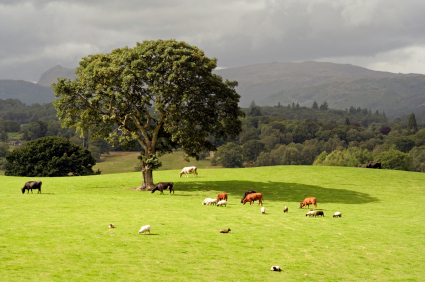 Mistletoe is steeped in lore from pre-Christian times, so much so that it might be easier to cover powers not attributed to this revered plant than those that are. Viscum album, the genus that grows in Great Britain and much of Europe, is recognized by its smooth-edged oval evergreen leaves borne in pairs along the woody stem, and waxy white berries, thought to be poisonous, in dense clusters of 2 to 6. Mistletoe is rare in Scotland, but references to it arise in Scottish herbals, so perhaps it was brought in from other regions of Britain. A similar species of mistletoe grows in North America with shorter, broader leaves and longer clusters of 10 or more berries. An evergreen parasitic plant, mistletoe grows on the branches of trees and derives all its nourishment from its host. The sticky berries, transferred by birds, attach themselves to the bark and send out roots. Because the plant prefers softer bark, it’s found more commonly on apple trees and is rarer on oaks which made mistletoe discovered on oaks greatly venerated by ancient Celts, Germans, and it was used in ceremonies by early Europeans. Greeks and other early peoples thought it had mystical powers and the plant gained a wealth of folklore over the centuries. Sacred to the Druids, many wondrous attributes are accorded to mistletoe, including medicinal powers, properties to boost fertility, and ward off evil spells.
Mistletoe is steeped in lore from pre-Christian times, so much so that it might be easier to cover powers not attributed to this revered plant than those that are. Viscum album, the genus that grows in Great Britain and much of Europe, is recognized by its smooth-edged oval evergreen leaves borne in pairs along the woody stem, and waxy white berries, thought to be poisonous, in dense clusters of 2 to 6. Mistletoe is rare in Scotland, but references to it arise in Scottish herbals, so perhaps it was brought in from other regions of Britain. A similar species of mistletoe grows in North America with shorter, broader leaves and longer clusters of 10 or more berries. An evergreen parasitic plant, mistletoe grows on the branches of trees and derives all its nourishment from its host. The sticky berries, transferred by birds, attach themselves to the bark and send out roots. Because the plant prefers softer bark, it’s found more commonly on apple trees and is rarer on oaks which made mistletoe discovered on oaks greatly venerated by ancient Celts, Germans, and it was used in ceremonies by early Europeans. Greeks and other early peoples thought it had mystical powers and the plant gained a wealth of folklore over the centuries. Sacred to the Druids, many wondrous attributes are accorded to mistletoe, including medicinal powers, properties to boost fertility, and ward off evil spells.
From A Modern Herbal: Mistletoe was held in great reverence by the Druids. They went forth clad in white robes to search for the sacred plant, and when it was discovered, one of the Druids ascended the tree and gathered it with great ceremony, separating it from the Oak with a golden knife. The Mistletoe was always cut at a particular age of the moon, at the beginning of the year, and it was only sought for when the Druids declared they had visions directing them to seek it. When a great length of time elapsed without this happening, or if the Mistletoe chanced to fall to the ground, it was considered as an omen that some misfortune would befall the nation. The Druids held that the Mistletoe protected its possessor from all evil, and that the oaks on which it was seen growing were to be respected because of the wonderful cures which the priests were able to effect with it. They sent round their attendant youth with branches of the Mistletoe to announce the entrance of the new year. It is probable that the custom of including it in the decoration of our homes at Christmas, giving it a special place of honour, is a survival of this old custom.
The curious basket of garland with which ‘Jack-in-the-Green‘ is even now occasionally invested on May-day is said to be a relic of a similar garb assumed by the Druids for the ceremony of the Mistletoe. When they had found it they danced round the oak to the tune of ‘Hey derry down, down, down derry!’ which literally signified, ‘In a circle move we round the oak. ‘ Some oakwoods in Herefordshire are still called ‘the derry‘; and the following line from Ovid refers to the Druids’ songs beneath the oak:
‘Ad viscum Druidce cantare solebant’
Shakespeare calls it ‘the baleful Mistletoe,’ an allusion to the Scandinavian legend that Balder, the god of Peace, was slain with an arrow made of Mistletoe. He was restored to life at the request of the other gods and goddesses, and Mistletoe was afterwards given into the keeping of the goddess of Love, and it was ordained that everyone who passed under it should receive a kiss, to show that the branch had become an emblem of love, and not of hate.”
Parts Used Medicinally: The leaves and young twigs, collected just before the berries form, and dried in the same manner as described for Holly.
The preparations ordinarily used are a fluid extract and the powdered leaves. A homoeopathic tincture is prepared with spirit from equal quantities of the leaves and ripe berries, but is difficult of manufacture, owing to the viscidity of the sap.”
“Medicinal Action and Uses: Nervine, antispasmodic, tonic and narcotic. Has a great reputation for curing the ‘falling sickness’ epilepsy – and other convulsive nervous disorders. It has also been employed in checking internal haemorrhage.
***Bear in mind that although mistletoe has some possible medicinal qualities and has been used for centuries for various maladies, it is potentially toxic so do not administer it to yourself.
“Mistletoe was thought to be a remarkable and sacred shrub because it seemed to grow from the air and not from the earth. Mistletoe has been considered undesirable because it feeds off other trees; however it is also thought to have a symbiotic relationship because it provides nutrients when the host is in dormancy. It also provides food for a host of animals and birds who consume its leaves and shoots
Over time its folklore has grown to include the belief that the oak mistletoe could extinguish fire, that it held the soul of the host tree and placed in a baby’s cradle would protect the child from faeries.
 Kissing under the mistletoe is also cited in an early work byWashington Irving, “Christmas Eve,” which tells of the festivities surrounding the Twelve Days of Christmas:
Kissing under the mistletoe is also cited in an early work byWashington Irving, “Christmas Eve,” which tells of the festivities surrounding the Twelve Days of Christmas:
“Here were kept up the old games of hoodman blind, shoe the wild mare, hot cockles, steal the white loaf, bob apple, and snap dragon; the Yule-clog and Christmas candle were regularly burnt, and the mistletoe with its white berries hung up, to the imminent peril of all the pretty housemaids.”
Used as good luck charms to ward off evil, its sprigs were also put under the pillows of young girls who thought it would entice dreams of the husband to be.”
“Mistletoe is also said to be a sexual symbol, because of the consistency and color of the berry juice as well as the belief that it is an aphrodisiac, the “soul” of the oak from which it grows. The origin of the tradition of kissing under the mistletoe is vague. However, the tradition may have stemmed from either the Viking association of the plant with Frigga (the goddess of love) or from the ancient belief that mistletoe was related to fertility. Another explanation for the tradition is that it is derived from the festival of Saturnalia, a popular mid-December celebration in ancient Rome.
 The correct mistletoe etiquette is for the man to remove one berry when he kisses a woman. When all the berries are gone, there’s no more kissing permitted underneath that plant.
The correct mistletoe etiquette is for the man to remove one berry when he kisses a woman. When all the berries are gone, there’s no more kissing permitted underneath that plant.
One legend states that a couple who kisses underneath mistletoe will have good luck, but a couple neglecting to perform the ritual will have bad luck. Specifically, it is believed that a couple kissing under the mistletoe ensure themselves of marriage and a long, happy life, while an unmarried woman not kissed under the mistletoe will remain single for another year.”
***Mistletoe and werewolves: In some ancient lore, mistletoe is considered a repellent and protection from werewolves.
***Royalty free images of mistletoe, Druid, British Oak, couple kissing beneath mistletoe



No comments:
Post a Comment